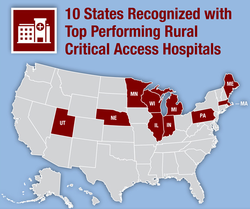
HRSA recognizes 10 states with top performing rural critical access hospitals

July 19 - The Health Resources and Services Administration (HRSA) is recognizing ten states for outstanding quality performance of their Critical Access Hospitals (CAHs) in achieving the highest reporting rates and levels of improvement over the past year.
The 10 top-performing states – Wisconsin, Maine, Utah, Minnesota, Illinois and Pennsylvania (tied), Michigan, Nebraska, Indiana and Massachusetts – built on their previous successes by investing Federal Office of Rural Health Policy (FORHP) funds into quality improvement projects and developing technical assistance resources that improve high-quality care in their communities. States also work collaboratively with every CAH and their respective partners to share best practices and utilize data to drive quality improvement in their hospitals.
|
Less than one week left to apply for AIMS funding (HRSA-17-118)

HRSA is accepting applications for the Access Increases in Mental Health and Substance Abuse Services (AIMS) supplemental funding opportunity. All current Health Center Program award recipients are encouraged to apply for up to $150,000 to expand access to mental health services and substance abuse services focusing on the treatment, prevention, and awareness of opioid abuse.
Visit the AIMS technical assistance website to access application resources, including frequently asked questions and a recording of the June 29 technical assistance webinar.
Applications are due by 5 p.m. EDT on July 26. Contact BPHCsupplement@hrsa.gov with questions.
|
HIV/AIDS Bureau releases new co-infection curriculum
Introducing the HIV/HCV Co-infection: An AETC National Curriculum.
HAB's Office of HIV/AIDS Training and Capacity Development just launched a new tool in the arsenal to cure hepatitis C (HCV) and reduce the incidence of HIV/HCV co-infection: the HIV/HCV Co-infection Curriculum.
The curriculum includes a suite of online materials for healthcare providers and trainers of healthcare providers to increase their knowledge of HIV/HCV co-infection among people of color in the United States including prevention, screening, diagnosis and treatment recommendations.
Curriculum Highlights:
This curriculum was developed as a component of the Secretary's Minority AIDS Initiative Fund Jurisdictional Approach to Curing Hepatitis C among HIV/HCV Co-infected People of Color.
|
New CDC report shows cancer death rates are falling more slowly in rural areas

A new Morbidity and Mortality Weekly Report from CDC found that people in rural areas of the U.S. get cancer less often, but die from it at higher rates.
The report provides the first comprehensive description of cancer incidence and mortality in rural and metropolitan counties in the United States.
|
That long pause was really a seizure: understanding epilepsy and bullying

How do you think a grade school class would react if a classmate suddenly became silent? They may not know what they are seeing, so they speculate and create stories about what is going on. Maybe he contracted an illness. Maybe she is so tired she was sleeping while awake. The stories may often be worse than reality for a child, especially one living with a chronic medical condition. The silent stare may be the result of an absent seizure.
Epilepsy is a neurological condition that causes the brain to seize. There are different types of seizures – some are more obvious because they affect movement and coordination. But others are not noticeable.
|
A cause with "national significance"

Homeless adults living with HIV -- and further stressed with mental illness or substance abuse -- have long been much harder to keep in care than the broader HIV-positive population of some 1.1 million Americans, half of whom receive health services through HRSA-funded Ryan White clinics nationwide. But their success rate markedly increases when they are adequately housed, results from a HAB outreach project show.
In one of the most hopeful advances in years, HIV viral suppression rates have increased from 69 to 83 percent among patients "who walk through the door to get health care at least once in a year," said Dr. Laura Cheever. Associate Administrator of the HIV/AIDS Bureau and a practicing Johns Hopkins clinician, she addressed researchers on June 27 at HRSA headquarters.
But people experiencing homelessness have rates of new infection as high as 16 times that of the general population.
Funding OpportunitiesHealth Workforce
Leadership in Public Health Social Work Education - Apply by August 7
HIV/AIDS
Improving HIV Health Outcomes through the Coordination of Supportive Employment and Housing Services — Demonstration Sites - Apply by July 24
Improving HIV Health Outcomes through the Coordination of Supportive Employment and Housing Services – Evaluation and Technical Assistance Provider - Apply by July 24
Curing Hepatitis C among People of Color Living with HIV - Apply by July 28
Ryan White HIV/AIDS Program Part C HIV Early Intervention Services Program: Existing Geographic Service Areas (HRSA-18-001) - Apply by August 14
Ryan White HIV/AIDS Program Part C HIV Early Intervention Services Program: Existing Geographic Service Areas (HRSA-18-004) - Apply by August 14
Ryan White HIV/AIDS Program Part C HIV Early Intervention Services Program: Existing Geographic Service Areas (HRSA-18-005) - Apply by August 14
Maternal & Child Health
State Systems Development Initiative Grant Program – Tier 1 (Jurisdictions) - Apply by September 5
State Systems Development Initiative Grant Program – Tier 2 (States and DC) - Apply by September 5
Primary Health Care/Health Centers
FY 2017 Access Increases in Mental Health and Substance Abuse Services (AIMS) Supplemental Funding Opportunity Technical Assistance - Apply by July 26
Service Area Competition - Apply by August 21
Service Area Competition - Apply by September 11
Rural Health
Rural Health Opioid Program - Apply by July 21
|






















.png)









No hay comentarios:
Publicar un comentario